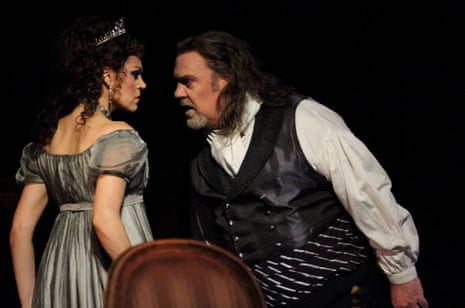There has to be an imperative for returning to an all-time popular opera in its umpteenth revival, in this case the Royal Opera’s 2006 Tosca, back for the ninth time. In fact no reason is needed. Every encounter with Puccini’s work offers a masterclass in the art of opera. If we’re interested in the form, as newcomer or veteran, we should submit to its inexhaustible qualities as often as possible: its economy and detail, its fearless conjunctions of political and personal, grand set piece and intimate drama, all bound into a score of cumulative potency.
The lessons of Tosca, and above all its intensity and passion (which is why we go; forget self-improvement), burn bright even if the performance itself doesn’t hit the mark. For this summer run, Jonathan Kent’s staging, with Paul Brown’s heavy, magnificent sets, has a star lineup, with Bryn Terfel chilling and unmissable as Scarpia, the corrupt chief of police. The Welsh bass-baritone dominates the stage with imposing, pulsating villainy, moving as if in a tight corset, upright, rigid with barely contained lust and anger, ready to devour his latest prey – the diva Tosca – before spitting her out in quest of the next new thing.
Terfel created this role when the production was new, overcoming the physical constraints of the staging, especially in Act 1 where a double staircase means performers are forced to go up, then down. Then up, then down. He treasures every note and gesture, remaining vocally nuanced even when soaring above an orchestra at full whack. He can make a pianissimo “Well?”, whispered offensively close into Tosca’s ear – don’t you hate a man who does that? – sound as crude and erotic as language gets.
Scarpia’s rival Cavaradossi is sung with clarion panache by the Italian tenor Vittorio Grigolo. Where Terfel stands rock-like, Grigolo is agile and fidgety. It’s not a subtle performance, but he certainly delivers, in both volume and high notes. His curtain call, complete with deep genuflection and hands-together, hands-apart routine, deserves its own review. What of Tosca herself? The Latvian soprano Kristine Opolais (she shares the role with Angela Gheorghiu) sounded out of sorts, assured in the moments of high passion, as in Scarpia’s study in Act 2, but uneven and brittle elsewhere. This most famous of roles, flickering emotionally from jealousy to joy, love to destructive horror, can seem one of the least sympathetic unless the performer can intimate shadow and depth. Michael Mofidian, a valiant Angelotti, and Jonathan Lemalu as the bumbling Sacristan added lustre. The ROH orchestra, especially the principal clarinet – at the start of E lucevan le stelle and throughout – gave Puccini’s rich score rampant life under the efficient baton of Alexander Joel.
Antonio Pappano was the original conductor of this production. The music director of the Royal Opera House spends much of his non-ROH life in the city at the centre of Puccini’s opera: Rome. As music director, since 2005, of Rome’s Orchestra dell’Accademia Nazionale di Santa Cecilia, Pappano has developed the international profile of Italy’s first symphony orchestra (independent of an opera house). Not that it was without style. Leonard Bernstein loved this exuberant and glamorous orchestra. Every big name has conducted it, including Richard Strauss and, late in his life, Gustav Mahler.
Arriving at London’s Barbican at the end of a European tour, the Santa Cecilia musicians performed Mahler’s Symphony No 6, with robust conviction, to a capacity audience. Without ado, the army of double basses launched into the snarling march that ignites this work, strings and oboes joining in with ferocious urgency, the entire enlarged orchestra soon unfurling with demonic zeal, complete with a craze of cowbells, sweet celesta, and two almighty, test-your-strength hammer blows.
Pappano favours the Scherzo-Andante order of the central movements. Mahler’s original thought, Andante-Scherzo, is now generally preferred, but don’t get me started. (Last time I entertained doubt on the matter, the composer and Mahler scholar Colin Matthews sent me a detailed and convincing evidence-based explanation as to why no one should consider that the Scherzo – a rejig of that angry march, almost as if the opening movement is beginning again – should come first, while acknowledging that many eminent musicians still do.) Anyway, Pappano made a strong case. When the warm melody of the Andante at last arrives, it sounds all the more ecstatic and radiant. The rapport between conductor and orchestra was ever evident in this sprawling, terrifying depiction of cataclysm: Mahler at his darkest.

The concept of “best” in live musical performance is elusive and unquantifiable. Hear Mitsuko Uchida perform Schubert one day, András Schiff the next and both might appear supreme. Each musician has conveyed the music in a way that speaks immediately and convincingly. Given their long careers, that impression grows with time. Then someone new comes along, and you find they too are “best”. Igor Levit, now in his early 30s, is one. He delights in the colossal. This was clear when in 2015, in one set, he recorded Bach’s Goldberg Variations, Beethoven’s Diabelli Variations and Frederic Rzewski’s The People United Will Never Be Defeated.
The Russian-born, Berlin-based pianist, across two evenings, brought all three works to Wigmore Hall, applying wit, technical wizardry and incisive musical and intellectual command to each. (In a third concert in this marathon, he played Ronald Stevenson’s Passacaglia on DSCH.)
Levit has long been a champion of the American Rzewski (b1938), whose variations on a Chilean revolutionary song skates winningly, and expansively, from avant garde to smoky jazz. As the catchy title tune came back, the words kept rearranging themselves in my head: the people defeated will never be united. There’s a message there somewhere.
Star ratings (out of five)
Tosca ★★★
Orchestra of Santa Cecilia/Pappano ★★★★
Igor Levit ★★★★★
Tosca is in rep at the Royal Opera House, London, until 15 July

Comments (…)
Sign in or create your Guardian account to join the discussion